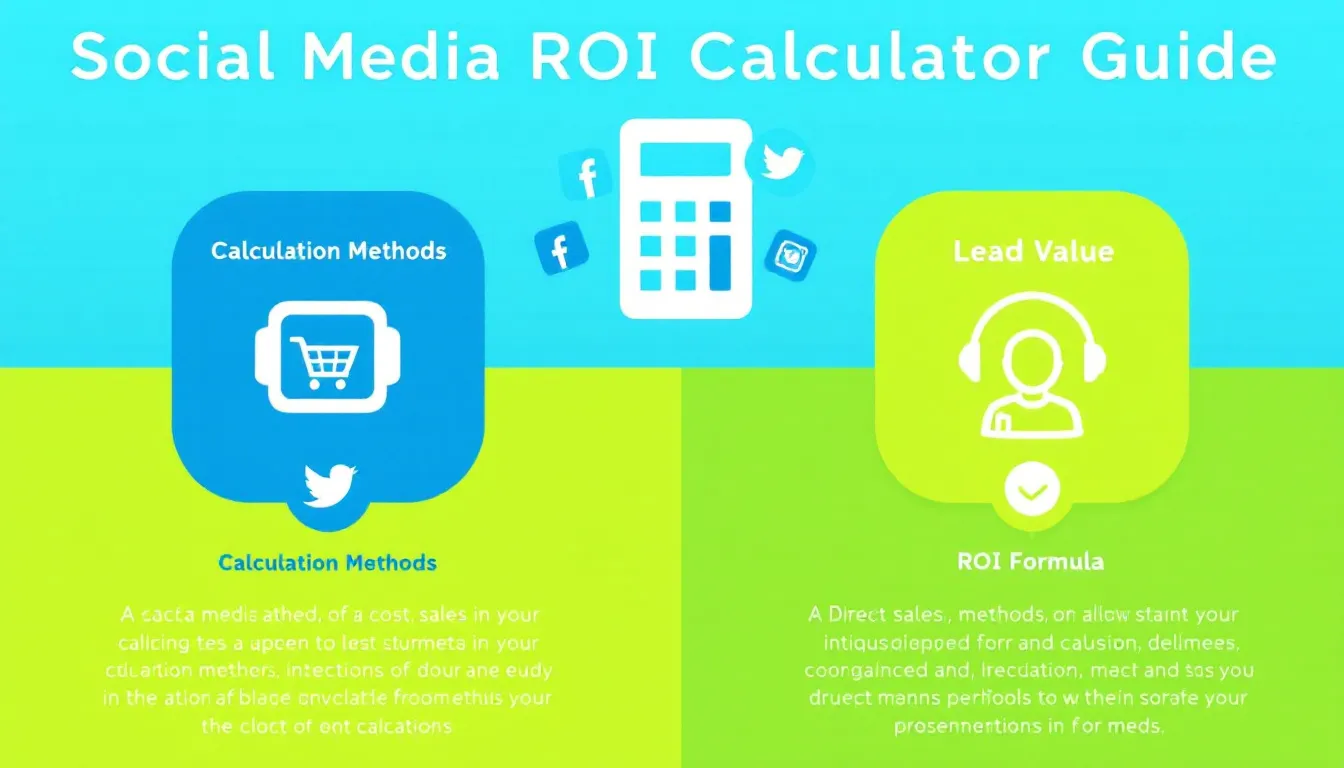Social Media ROI Calculator
Results
Total Investment:
Total Return:
Net Profit:
ROI:
Is this tool helpful?
How to Use the Social Media ROI Calculator Effectively
This Social Media ROI Calculator helps you measure the financial impact of your social media marketing efforts. It offers two calculation methods and various input fields so you can tailor the results based on how you track your campaigns. Here’s how to use each part of the tool:
Step 1: Choose Your Calculation Method
- Direct Sales Revenue Method: Use when you can directly link social media campaigns to sales. For example, entering total sales from a specific campaign.
- Lead Value Calculation Method: Use this when you track leads and conversions instead of direct sales revenue.
Step 2: Provide Revenue or Lead Data
If you picked the Direct Sales Revenue Method:
- Total Sales Revenue: For example, enter 18,500 (USD) from a recent campaign.
If you selected the Lead Value Calculation Method:
- Number of Leads: Example input 950 leads generated from social media
- Conversion Rate (%): Example input 7.5% of leads that became customers
- Average Sale Value (USD): Example input 130.00 average revenue per sale
Step 3: Enter Your Investment Costs
- Advertising Costs: Enter your social media ad spend. Example: 2,800 USD
- Content Creation Costs: Include expenses for graphics, videos, and posts. Example: 1,200 USD
- Labor Costs: Add staff or management expenses related to social media. Example: 3,700 USD
- Software and Tools Costs: Include subscription fees for social media platforms or analytics tools. Example: 350 USD
Introduction to the Social Media ROI Calculator
Measuring the success of your social media campaigns is crucial for effective marketing. The Social Media ROI Calculator helps you quantify your return on investment by comparing the revenue generated with the costs incurred. Whether you track direct sales or prefer to calculate ROI based on leads and conversion data, this tool provides clarity on your campaign’s profitability.
Using this calculator lets you:
- Determine which social channels yield the best returns
- Optimize spending on ads, content, and labor
- Make strategic adjustments to improve future campaigns
How ROI Is Calculated in This Tool
The calculator uses the standard return on investment formula:
When you select the lead-based calculation method, the “Return” is determined by the following formula:
This calculation estimates the revenue generated from leads by applying your conversion rate and average sale value.
Sample Calculations Using the Social Media ROI Calculator
Example 1: Direct Sales Revenue Method for a Retail Campaign
- Advertising Costs: $4,000
- Content Creation Costs: $2,500
- Labor Costs: $5,000
- Tools Costs: $400
- Total Investment: $11,900
- Total Sales Revenue: $38,000
- Net Profit: $26,100 (Revenue – Investment)
- ROI: 219.33%
Example 2: Lead Value Calculation for a B2B Software Campaign
- Investment: $7,500 total (ads, content, labor, tools)
- Number of Leads: 1,000
- Conversion Rate: 5%
- Average Sale Value: $3,000
- Return: $150,000 (1,000 × 0.05 × $3,000)
- Net Profit: $142,500
- ROI: 1900%
Why Use This Social Media ROI Calculator for Your Marketing
1. Improve Strategic Budgeting
You can identify the social media channels and tactics that deliver the strongest results, helping you allocate your marketing budget wisely.
2. Track Campaign Performance Accurately
Monitoring ROI over time reveals what’s working and what isn’t, enabling data-driven decision-making.
3. Optimize Marketing Resources
The tool helps you spot areas where you can reduce costs without sacrificing effectiveness, maximizing the impact of your resources.
FAQs About Measuring Social Media Marketing ROI
How often should you calculate your social media ROI?
Calculate ROI at least monthly or quarterly to observe trends and adjust your campaigns promptly.
What is considered a good social media ROI percentage?
An ROI above 100% means you’re earning more than you spend. However, the ideal ROI depends on your industry and campaign goals.
Should organic social media efforts be included in ROI calculations?
Yes. Include time and resources spent on organic content and community management to get a full picture of your investments.
How do you track social media’s contribution to direct sales?
Use tracking tools like UTM parameters, conversion pixels, and analytics platforms to attribute sales accurately.
Besides ROI, which metrics should you monitor?
Track engagement rates, reach, click-through rates, and customer lifetime value to better understand overall social media performance.
Tips to Increase Accuracy in Your ROI Calculations
1. Keep Detailed Investment Records
- Track all costs, including hidden expenses like training or technology upgrades.
- Document time spent on social media management.
2. Use Proper Revenue Attribution Methods
- Apply tracking codes on all your social media links.
- Use platform-specific conversion tracking to measure precise sales impact.
- Consider both direct sales and indirect influences from social media efforts.
3. Perform Regular Performance Analysis
- Compare ROI results from different social platforms.
- Account for seasonal trends and campaign timing.
- Look for patterns that can inform future marketing strategies.
Using ROI Results to Enhance Your Social Media Strategy
Leverage your ROI insights to:
- Refine and better target your audience segments
- Focus your content creation on higher-performing types
- Adjust advertising spend for maximum efficiency across platforms
- Improve lead nurturing and conversion processes
- Create social media campaigns that deliver measurable revenue growth
Important Disclaimer
The calculations, results, and content provided by our tools are not guaranteed to be accurate, complete, or reliable. Users are responsible for verifying and interpreting the results. Our content and tools may contain errors, biases, or inconsistencies. Do not enter personal data, sensitive information, or personally identifiable information in our web forms or tools. Such data entry violates our terms of service and may result in unauthorized disclosure to third parties. We reserve the right to save inputs and outputs from our tools for the purposes of error debugging, bias identification, and performance improvement. External companies providing AI models used in our tools may also save and process data in accordance with their own policies. By using our tools, you consent to this data collection and processing. We reserve the right to limit the usage of our tools based on current usability factors.







